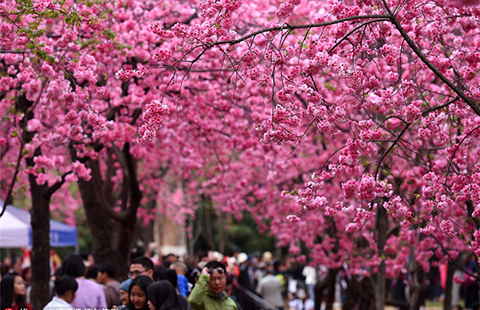Tough strut from world's factory to fashion empire
Updated: 2016-03-25 13:56
(Xinhua)
|
||||||||
Individualizing
For the last three decades, Luojiaji has operated under a fixed model like any other manufacturing hub in China: earning money by quantity and churning out tens of thousands of same T-shirts.
Zhang Donghong, vice manager of Huajun garment company, said a single order could reach 500,000 shirts, and the smallest was 50,000 pieces.
"We wouldn't do anything fewer than that, because we counted on the large quantity to make profit," he said. The company made 50 cents from each shirt.
The pattern had been forced to change. "Customers have become more discerning, and nobody likes to meet her twin," said Zhang. Now executives like Zhang are worried big orders will hurt employee skill levels.
The E-shopping age also means more individualized demands. Earlier this year, a Welsh customer ordered 100 men's shirts, worth $819. "By reaching to end customers, we earn 50 percent more than wholesaling," said Zhang.
The shirts were sent to the customer through DHL delivery. Huajun company has hired 50 workers to handle such orders from online commerce platforms of Alibaba, Ebay and Amazon.
Many companies have tapped into domestic buyers, a traditionally blind spot. Thirty-five percent of the sales of Huaxing garment company, one of the biggest in Luojiaji, were made by domestic buyers last year.
Cutting cost
Li Chunming, owner of the Jiangxi Global Textile and Garment Company, has just lost a big client. "A partner whose annual sales were 300 million yuan jumped camp to southwestern Asian countries," Li said.
"Factories in Vietnam and Bangladesh have snatched away orders at prices 20 percent lower than ours," said Li.
For the past years, orders have kept growing by 10-15 percent every year in Luojiaji. Before 2015, companies had to fight for workers to meet growing orders. But last year, the orders did not grow at all, company executives told Xinhua.
"I have been advised to open a factory in a southwestern Asian country," Li said.
For Luojiaji factories, cost-cutting is inevitable. The Huaxing company bought an automated hanging system, which replaced 15 percent of the workers. Laser cutting equipment helped save 20 percent of the fabric than manual cutting.
- Garment market near zoo closing, moving to Hebei province
- Garment firm shifts its focus to robotics
- Annual Garment and Textile Fair opens in Dalian
- Technology is more than a fashion trend for firms in garment city
- Victoria's Secret to open annual garment show in Dalian
- Wuxi garment tycoons on Forbes wealth list
- Replica of ancient plain silk gauze garment on exhibit in Nanjing
- China to help boost Xinjiang's textile and garment sectors
- APEC honors Suzhou silk garment maker with medal

 First lady Peng Liyuan leads fight against tuberculosis
First lady Peng Liyuan leads fight against tuberculosis
 Faces at Boao Forum for Asia Annual Conference
Faces at Boao Forum for Asia Annual Conference
 In photos: Lunar eclipses visible in eastern China
In photos: Lunar eclipses visible in eastern China
 Chinese chasing Spring blossoms around the country
Chinese chasing Spring blossoms around the country
 Migrant couple returns to hometown to raise chickens
Migrant couple returns to hometown to raise chickens
 Victims of Brussels attacks commemorated
Victims of Brussels attacks commemorated
 In photos: Brussels rocked by multiple explosions
In photos: Brussels rocked by multiple explosions
 Raul Castro and Obama hold talks in Havana
Raul Castro and Obama hold talks in Havana
Most Viewed
Editor's Picks

|

|

|

|

|

|
Today's Top News
Marriott unlikely to top Anbang offer for Starwood: Observers
Chinese biopharma debuts on Nasdaq
What ends Jeb Bush's White House hopes
Investigation for Nicolas's campaign
Will US-ASEAN meeting be good for region?
Accentuate the positive in Sino-US relations
Dangerous games on peninsula will have no winner
National Art Museum showing 400 puppets in new exhibition
US Weekly

|

|







